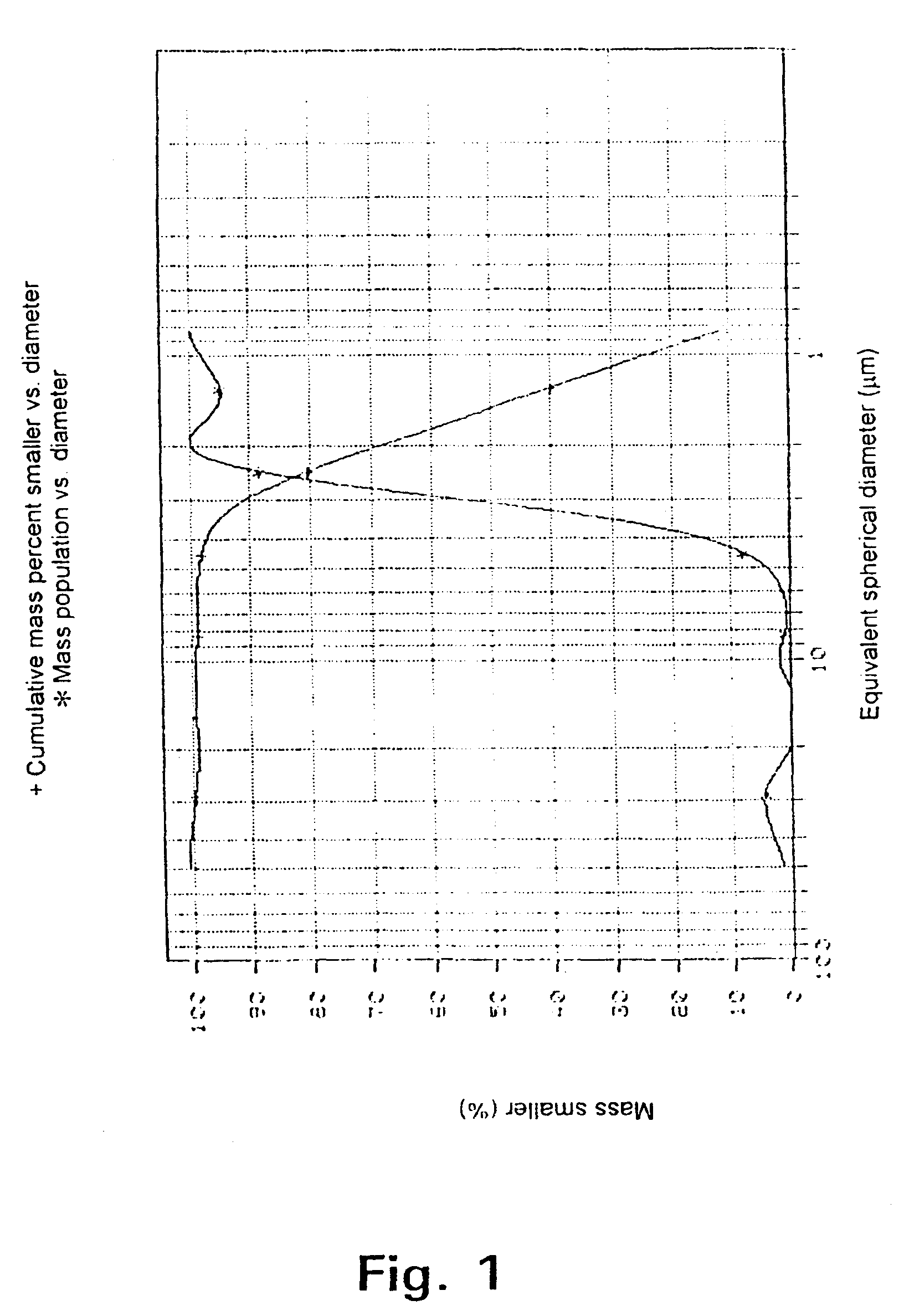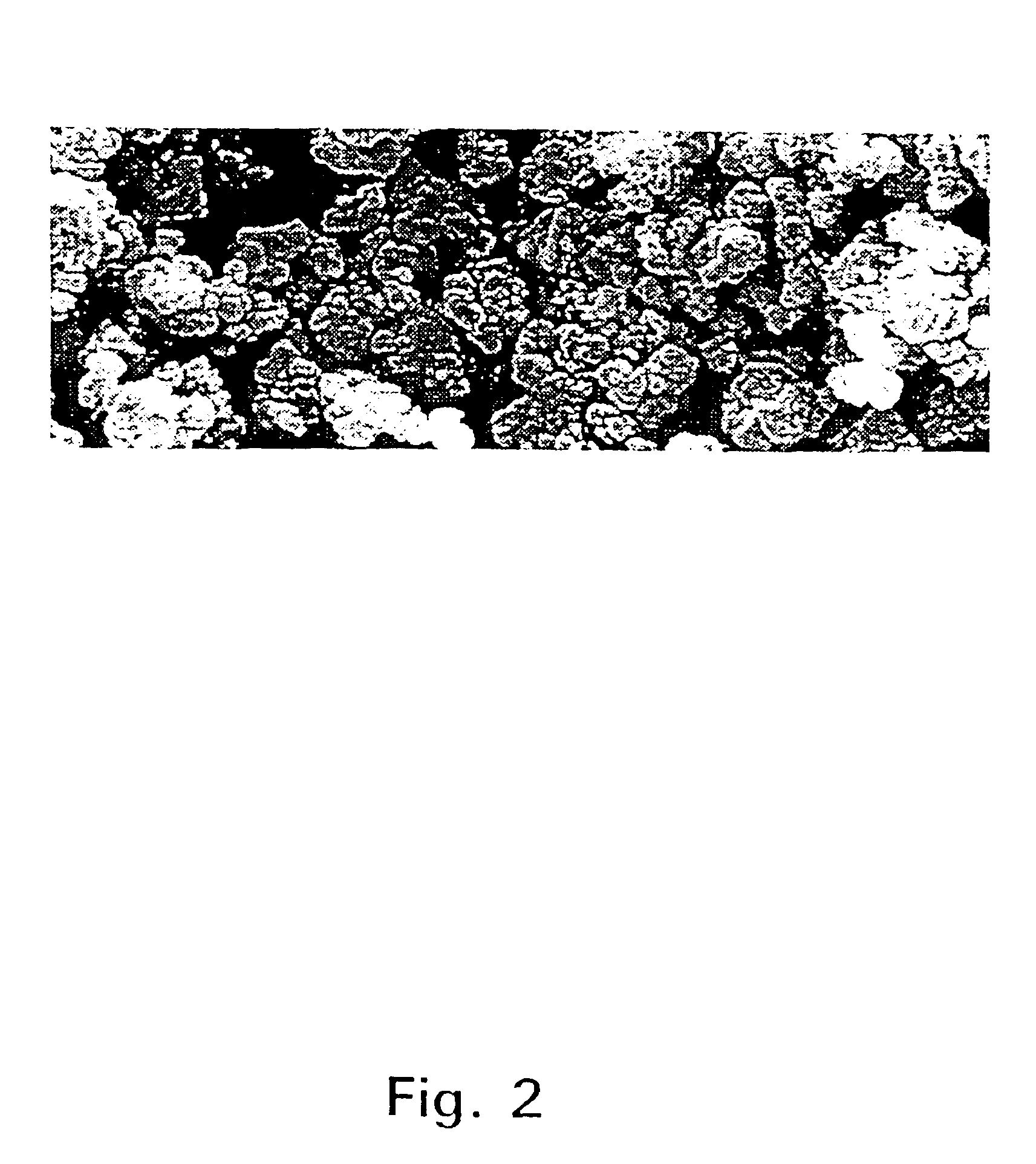Process for regulating the porosity and printing properties of paper by use of colloidal precipitated calcium carbonate, and paper containing such colloidal precipitated calcium carbonate
a technology of colloidal precipitation and printing properties, which is applied in the field of process for regulating the porosity and printing properties of paper by using colloidal precipitation calcium carbonate, can solve the problems of printing blurring, low porosity of paper, and smudging
- Summary
- Abstract
- Description
- Claims
- Application Information
AI Technical Summary
Benefits of technology
Problems solved by technology
Method used
Image
Examples
example 1
Regulation of Porosity in SC Paper
[0055]The following pigments were tested in SC paper:
[0056]
Kaolin referenceRhombohedral PCCColloidal PCCFiller - MStandard productExperimental(ECC(Faxe Paperproduct (Faxe PaperInternational)Pigments A / S)Pigments A / S)Brightness78.997.095.9(R457-ISO,%)MPS (μm)3.31.81.1BET9.06.225(m2 / g)
[0057]The test was carried out on a pilot paper machine with filler levels of 27, 30 and 33%.
[0058]The fibers were of Scandinavian origin and consisted of:[0059]TMP (thermomechanical pulp) and GW (groundwood) 85%[0060]Kraft (cellulose fibers processed by the “kraft” process) 15%
[0061]The following chemicals were used in the manufacturing process:[0062]Retention agent none[0063]Other none[0064]pH adjusted to 7.3 by addition of H3PO4.
[0065]For comparison purposes the results for paper are interpolated to 30% filler after calendering. The results are shown in the table below.
[0066]
Kaolin referenceRhombohedral PCCColloidal PCCGram weight555656(g / m2)Thickness (μm)495455Densit...
example 2
Reduction of Porosity of Newsprint using Colloidal PCC as Filler
[0068]The following pigments were tested in newsprint:
[0069]
ReferenceColloidal PCCCalcinedFaxe Chalk 89RhombohedralExperimentalKaolinChalkPCCproduct(Ansilex from(Faxe Kridt(Faxe Paper(Faxe PaperEngelhard)A / S)Pigments A / S)Pigments A / S)Brightness89.687.496.295.7(R457-ISO, %)MPS (μm)0.91.51.21.1BET (m2 / g)15.03.29.223.0
[0070]The test was carried out on a pilot paper machine with filler levels from 2-10%.
[0071]The fibres consisted of:[0072]Unbleached TMP (thermomechanical pulp) 95%[0073]Bleached cellulose prepared by the sulphate process 5%
[0074]The following chemicals were used in the preparation:[0075]Retention agent Percol 23OL (cationic polyacrylamide from Allied Colloids)[0076]Other none[0077]pH adjusted to 7.3 by addition af H2SO4.
[0078]For comparison purposes the results for paper are interpolated to 4% filler. The results are given in the following table, the gram weight of the papers being 46 g / m2.
[0079]
ReferenceCol...
example 3
[0082]A pigment mixture consisting of 50 parts (by weight) fine scalenohedral PCC, 30 parts fine rhombohedral PCC and 20 parts colloidal PCC was tested in production scale as a filler in SC-A grade paper at a commercial paper mill. The PCC pigment mixture was pH-stabilised by addition of a small amount of phosphoric acid in order to avoid the need for acid addition on the paper machine for pH-control. The properties of the PCC mixture and the reference clay filler used in the trial are listed in the table below.
[0083]
Experimental PCC mixtureReference kaolin clay(Faxe Paper Pigments(European filler grade)A / S)Brightness (R457-79.294.1ISO %)MPS (μm)1.381.62BET surface area11.710.8(m2 / g)
[0084]The pulp finish composition was 50 parts deinked pulp (DIP), 40-45 parts groundwood (GW) and 5-10 parts Kraft pulp.
[0085]The trial PCC mixture was tested at a constant total filler level with two levels of PCC addition. The balance to give the total amount of filler is reference clay and filler int...
PUM
| Property | Measurement | Unit |
|---|---|---|
| size | aaaaa | aaaaa |
| size | aaaaa | aaaaa |
| diameter | aaaaa | aaaaa |
Abstract
Description
Claims
Application Information
 Login to View More
Login to View More - R&D
- Intellectual Property
- Life Sciences
- Materials
- Tech Scout
- Unparalleled Data Quality
- Higher Quality Content
- 60% Fewer Hallucinations
Browse by: Latest US Patents, China's latest patents, Technical Efficacy Thesaurus, Application Domain, Technology Topic, Popular Technical Reports.
© 2025 PatSnap. All rights reserved.Legal|Privacy policy|Modern Slavery Act Transparency Statement|Sitemap|About US| Contact US: help@patsnap.com


